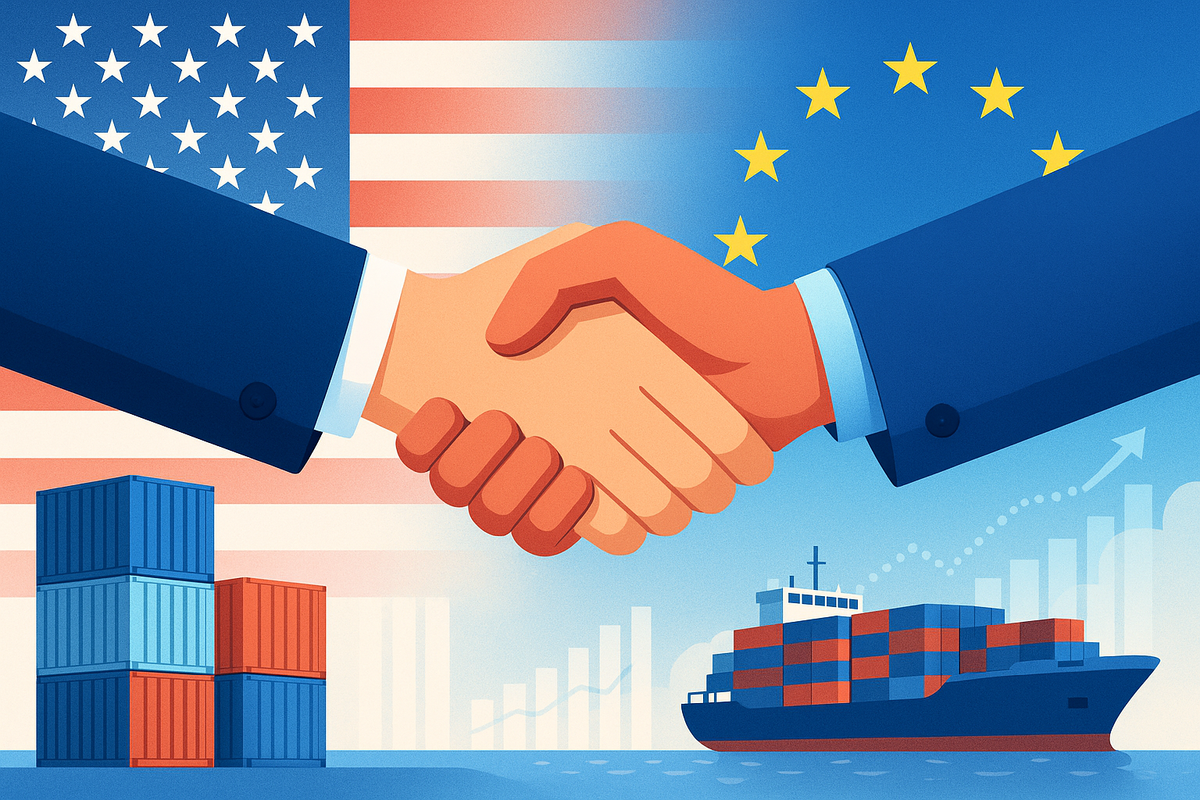
In a significant move poised to reshape global trade dynamics, the United States and the European Union have unveiled a new "Framework on an Agreement on Reciprocal, Fair, and Balanced Trade." Announced on August 21, 2025, this foundational agreement aims to invigorate one of the world's largest trade and investment relationships, addressing long-standing imbalances and fostering economic reindustrialization across both continents. The immediate implications are substantial, promising a significant reduction in tariffs and preferential market access that could unlock billions in new trade and investment flows.
This landmark framework signals a concerted effort by both economic powerhouses to deepen their economic ties and create a more predictable and equitable trading environment. By tackling key areas such as industrial goods, agricultural products, and critical technologies, the agreement is set to provide a much-needed boost to businesses and consumers on both sides of the Atlantic, potentially mitigating inflationary pressures and stimulating economic growth.
A New Chapter in Transatlantic Trade: Details and Driving Forces
The newly announced trade framework represents a pivotal moment in US-EU relations, designed to dismantle trade barriers and foster greater economic integration. At its core, the agreement outlines a series of reciprocal commitments that promise to significantly alter the landscape for goods and services flowing between the two blocs.
Specifically, the European Union has committed to the outright elimination of tariffs on all U.S. industrial goods. This sweeping measure is expected to provide a substantial advantage for American manufacturers, allowing their products to compete more effectively in the vast European market. Beyond industrial goods, the EU will also grant preferential market access for a diverse range of U.S. agricultural and seafood products, including tree nuts, dairy products, fresh and processed fruits and vegetables, processed foods, planting seeds, soybean oil, pork, and bison meat. Furthermore, the EU will extend and expand the scope of the Joint Statement on a Tariff Agreement concerning lobster, which had previously expired.
In a reciprocal move, the United States has outlined its own tariff adjustments. The U.S. will apply the higher of either its Most Favored Nation (MFN) tariff rate or a combined tariff rate of 15% (comprising the MFN tariff and a reciprocal tariff) on originating goods from the European Union. This effectively sets a blanket 15% tariff on most European imports, a notable reduction from a previously discussed 30% sweeping rate. Certain products, however, will benefit from MFN-only tariffs starting September 1, 2025, including unavailable natural resources like cork, all aircraft and aircraft parts, and generic pharmaceuticals and their ingredients. Crucially, tariffs on European automobiles and automobile parts will be reduced to 15% from the previous 27.5% (or 2.5% MFN plus Section 232 tariffs) once the EU formally enacts its tariff reductions on U.S. industrial goods. The U.S. has also reiterated a commitment to cap tariffs on semiconductors and lumber at 15%.
Beyond tariffs, the framework encompasses broader commitments aimed at strengthening economic cooperation. The EU intends to procure U.S. liquefied natural gas, oil, and nuclear energy products valued at an estimated $750 billion through 2028, alongside a commitment to purchase at least $40 billion worth of U.S. AI chips for its computing centers. European companies are also expected to invest an additional $600 billion in strategic U.S. sectors, including advanced manufacturing, semiconductors, and pharmaceuticals, through 2028. Both sides have pledged to address unjustified digital trade barriers, with the EU confirming it will not adopt or maintain network usage fees and agreeing not to impose customs duties on electronic transmissions. The agreement also includes provisions for negotiating rules of origin to ensure the benefits primarily accrue to both parties. This comprehensive approach underscores a shared vision for a more integrated and resilient transatlantic economy.
Winners and Losers Emerge in the Transatlantic Trade Shake-Up
The new US-EU trade framework is poised to create a distinct set of winners and losers across various industries, as companies grapple with the implications of altered tariffs, market access, and investment commitments.
On the winning side, U.S. industrial goods manufacturers are set to be major beneficiaries. With the EU eliminating tariffs on all U.S. industrial goods, companies like General Electric (NYSE: GE), Caterpillar (NYSE: CAT), and 3M (NYSE: MMM) could see increased demand and improved competitiveness for their products in the European market. This tariff removal is expected to fuel exports and expand production, benefiting a wide array of American businesses. Similarly, U.S. agricultural and seafood producers are poised for significant gains. Preferential market access to the EU for products such as dairy, fresh and processed fruits and vegetables, soybean oil, pork, bison meat, and lobster will open new avenues for growth. Companies like Tyson Foods (NYSE: TSN) and Archer-Daniels-Midland (NYSE: ADM), along with numerous smaller agricultural enterprises, stand to benefit from streamlined requirements for sanitary certificates and increased market penetration.
U.S. energy companies are also looking at a substantial boost, with the EU committing to purchase an estimated $750 billion worth of liquefied natural gas (LNG), oil, and nuclear energy products through 2028. This long-term commitment provides a stable and lucrative market for major energy players such as ExxonMobil (NYSE: XOM), Chevron (NYSE: CVX), and various LNG exporters. The U.S. tech sector, particularly AI chip manufacturers, will also see a significant uplift, as the EU pledges to acquire at least $40 billion worth of U.S. AI chips for its computing centers. This will directly benefit companies like NVIDIA (NASDAQ: NVDA) and Intel (NASDAQ: INTC). Furthermore, the commitment of $600 billion in EU investment into strategic U.S. sectors like advanced manufacturing, semiconductors, and pharmaceuticals will provide a capital injection for numerous American companies. U.S. aircraft manufacturers like Boeing (NYSE: BA) and generic pharmaceutical companies will also benefit from the U.S. applying only Most Favored Nation (MFN) tariffs to EU aircraft and generic pharmaceuticals from September 1.
Conversely, several European sectors face potential headwinds. European automakers, despite a reduction in U.S. tariffs on EU-made automobiles and parts from 27.5% to 15%, still face a significant cost burden. This 15% tariff, while lower than previously threatened rates, could impact the competitiveness of companies like Volkswagen (XTRA: VOW3), Mercedes-Benz Group (XTRA: MBG), and Stellantis (NYSE: STLA), particularly those with limited U.S. production facilities. There are concerns that this could lead to job losses in Europe as automakers consider shifting production to the U.S. to circumvent tariffs. European agricultural producers may also face increased competition and margin pressure due to the preferential market access granted to U.S. agricultural products. While some EU member states may resist opening their markets further, the influx of U.S. goods could challenge local producers.
European wine and spirits producers are another sector facing disappointment, as the agreement did not secure a tariff exemption for their products, meaning they will continue to face a 15% U.S. tariff. This could significantly impact companies like Pernod Ricard (EPA: RI) and Diageo (NYSE: DEO), potentially leading to reduced exports and halted investments in the U.S. For EU companies whose goods currently have MFN tariff rates lower than 15%, the new U.S. tariff ceiling could effectively increase their costs, making them less competitive. Finally, while not a direct company impact, the EU's commitment to purchasing U.S. AI chips, while beneficial for U.S. firms, is seen by some as a setback for proponents of European technological sovereignty, as it prolongs the bloc's reliance on U.S. technology.
Industry Impact and Broader Implications: A New Global Trade Paradigm
The US-EU trade agreement, formalized in August 2025, is not merely a bilateral pact; it represents a significant recalibration of global trade dynamics, with profound implications for various industries, supply chains, and international trade policy. This agreement, which sets a 15% tariff ceiling on many EU imports to the U.S. while the EU eliminates tariffs on U.S. industrial goods, is poised to reshape the competitive landscape and influence broader economic trends.
The automotive industry stands at a critical juncture. While the U.S. reduction of tariffs on European autos and auto parts to 15% from a previous 27.5% offers some relief, it is contingent on the EU's reciprocal elimination of tariffs on U.S. industrial goods. This aims to stabilize the market for European manufacturers like BMW (XTRA: BMW) and Mercedes-Benz Group (XTRA: MBG), but they still face an additional cost burden compared to pre-agreement rates and fierce competition, particularly from Asian manufacturers. This could accelerate the trend of European automakers investing in U.S. production facilities to circumvent tariffs and localize supply chains. The pharmaceutical sector, a major export for the EU, will see U.S. tariffs capped at 15%, potentially helping maintain competitive pricing for European medications from companies like Bayer (XTRA: BAYN) and Roche (SIX: ROG). However, the agreement's broader implications for drug pricing and the potential for U.S. alignment with international benchmarks could squeeze margins for these firms.
The agreement also significantly impacts the semiconductor and advanced manufacturing sectors. The U.S. will cap tariffs on European semiconductors at 15%, while the EU's commitment to purchase at least $40 billion worth of U.S. AI chips and invest $600 billion in U.S. strategic sectors by 2028 will further incentivize reshoring and localized production. This benefits U.S. chipmakers like Micron Technology (NASDAQ: MU) and Qualcomm (NASDAQ: QCOM), and encourages European firms to establish U.S. facilities, fostering a more integrated transatlantic supply chain for critical technologies. The energy sector will witness a strengthening of U.S. energy dominance, as the EU pledges to procure $750 billion in U.S. liquefied natural gas (LNG), oil, and nuclear energy products through 2028. This aligns with the EU's decarbonization goals and efforts to secure resilient supply chains amidst geopolitical tensions, benefiting U.S. energy giants and LNG exporters.
The ripple effects extend beyond these core industries. The agreement is designed to stabilize trade relations, averting a potential trade war and fostering a more predictable trading environment, which is crucial given that the U.S. and EU are each other's largest trading partners. However, the pact is expected to redefine global supply chains through strategic reshoring and sector-specific incentives. Rules of origin provisions will further incentivize localized production, ensuring that benefits accrue predominantly to the U.S. or EU, potentially impacting countries outside the agreement. This signals a long-term shift towards regionalized supply chains, which could disadvantage other trading partners without similar agreements. The agreement's "unbalanced" advantage for American manufacturers due to the 15% tariff ceiling on EU goods while the EU eliminates tariffs on U.S. industrial products could weaken European competitiveness in key sectors like chemicals and machinery.
From a regulatory and policy perspective, the agreement introduces a uniform 15% tariff rate on approximately 70% of EU exports to the U.S., a significant increase from the average 1.2% rate applied in 2024, creating asymmetrical market access. The inclusion of rules of origin provisions will ensure that the agreement's benefits accrue predominantly to both trading partners, incentivizing production within the U.S. or EU. Regulatory cooperation aims to reduce non-tariff barriers through collaboration on automotive standards, sanitary and phytosanitary (SPS) measures, and facilitating mutual recognition of conformity assessments. Both sides have also committed to enhancing supply chain resilience and addressing non-market policies, signaling a broader focus on economic security. This agreement also marks a shift towards bilateralism, potentially undermining multilateral trade organizations like the World Trade Organization (WTO) and leading to a more fragmented global trading system. Historically, this agreement can be compared to the Transatlantic Trade and Investment Partnership (TTIP) negotiations, which aimed for comprehensive trade liberalization but ultimately failed. This current framework, while less ambitious in scope, represents a renewed effort to stabilize and formalize transatlantic trade relations after a period of tension.
What Comes Next: Navigating a New Transatlantic Trade Landscape
The newly established US-EU trade framework, while a significant step, is explicitly described as a "first step" in a process that can be expanded over time. This implies a dynamic and evolving trade relationship, with both short-term adjustments and long-term strategic considerations for businesses and policymakers alike.
In the short term, the immediate focus will be on the implementation of the agreed-upon tariff reductions. European automakers, for instance, are eagerly awaiting the formal introduction of EU legislation to enact its promised tariff cuts on U.S. goods, which will trigger the reduction of U.S. tariffs on European automobiles and parts from 27.5% to 15%. This immediate relief will be crucial for companies like Volkswagen (XTRA: VOW3) and Stellantis (NYSE: STLA) as they adjust their pricing and supply chain strategies. Similarly, U.S. industrial goods manufacturers and agricultural producers will be looking to capitalize on the EU's tariff elimination and preferential market access, ramping up exports and exploring new distribution channels. The commitments on energy and AI chip procurement will also begin to materialize, with U.S. energy companies and chip manufacturers preparing to meet the increased demand from the EU.
Looking further ahead, the long-term possibilities for this framework are multifaceted. While not a comprehensive free trade agreement like the previously stalled Transatlantic Trade and Investment Partnership (TTIP), the current framework is intended to be a foundation for deeper integration. This could involve ongoing negotiations to further reduce tariffs, address non-tariff barriers, and foster cooperation in new areas such as economic security, food standards, and digital trade. However, the long-term durability of the agreement remains uncertain, particularly given the potential for shifts in U.S. political dynamics and the possibility of future renegotiations or unilateral withdrawals. The prospect of a "TTIP 2.0" remains distant, especially with the looming possibility of a second Trump presidency, which could lead to renewed trade tensions and a more fragmented global trading system.
For businesses, strategic pivots and adaptations will be essential. European companies, particularly those in the automotive and pharmaceutical sectors, may need to re-evaluate their production strategies, potentially shifting manufacturing to lower-cost regions or absorbing costs by increasing U.S. prices. The EU's broader strategic adaptation involves diversifying its markets, restructuring supply chains, and asserting greater strategic autonomy by deepening trade and political ties with Asian and other global economies to reduce reliance on the U.S. market. This could lead to new joint ventures and technology-sharing agreements, creating new revenue streams and strengthening the EU's economic resilience. U.S. companies, on the other hand, will need to solidify their market presence in Europe, leveraging the tariff advantages and preferential access to expand their export capabilities.
Market opportunities will emerge for U.S. farmers, ranchers, fishermen, and manufacturers, as the agreement is expected to significantly increase U.S. exports. The EU's commitment to purchasing U.S. energy and making new investments in the U.S. will provide a substantial boost to U.S. oil and gas producers and defense contractors. For the EU, while facing new tariffs, the agreement provides predictability and avoids a more severe trade war scenario, and the reduction of U.S. tariffs on European automobiles is a significant relief. However, challenges remain, particularly for EU exporters facing the 15% U.S. tariff, which could lead to margin compression and force strategic re-evaluations. American consumers may also face higher prices on certain European goods due to the increased import tax. The non-legally binding nature of the current framework means that further detailed negotiations are required, introducing an element of uncertainty, and the inherent asymmetries in the deal could lead to future renegotiations or retaliatory measures.
Conclusion: A New Chapter, Cautious Optimism
The US-EU trade agreement marks a pivotal moment in transatlantic economic relations, signaling a concerted effort to stabilize and rebalance one of the world's most significant trade partnerships. The framework, unveiled on August 21, 2025, is a testament to the shared recognition of the need to address trade imbalances and foster economic growth through reduced tariffs and preferential market access.
The key takeaways from this agreement are clear: the EU's commitment to eliminating tariffs on U.S. industrial goods and providing preferential market access for U.S. agricultural and seafood products, coupled with the U.S.'s reciprocal application of a 15% tariff ceiling on most EU imports, will fundamentally alter the competitive landscape. This move is expected to unlock significant opportunities for U.S. exporters across various sectors, from manufacturing and agriculture to energy and technology. Conversely, certain European industries, particularly automakers and some agricultural and beverage producers, will face new challenges and may need to strategically adapt to the altered tariff environment.
Moving forward, the market will be closely watching the implementation of this framework and the subsequent negotiations that are expected to expand its scope. The agreement's impact on global supply chains, the potential for reshoring and localized production, and the broader shift towards bilateral trade agreements will be critical areas of observation. While the agreement offers a degree of predictability and stability, preventing a more damaging trade war, its long-term success will hinge on the political will of both sides to navigate ongoing challenges and build upon this foundational framework.
Investors should pay close attention to the performance of companies in the directly impacted sectors, particularly U.S. industrial goods manufacturers, agricultural producers, energy companies, and AI chip manufacturers, as they stand to benefit significantly. Conversely, European automakers and certain agricultural and beverage producers will require careful monitoring as they adjust to the new tariff structures. The broader implications for global trade, including the potential for a more fragmented trading system and the rise of regional supply chains, will also be crucial for long-term investment strategies. This agreement, while a positive step, ushers in a new era of transatlantic trade that demands cautious optimism and strategic foresight from all stakeholders.






